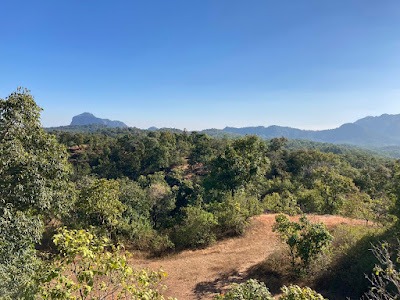
Image Source: usb1
About Pachmarhi Biosphere reserve
Located in the Satpura range of Madhya Pradesh, Pachmarhi Biosphere reserve is a protected landscape. In Central India, the Satpura range covers Betul, Chhindwara and Narmadapuram districts. It was established by the government of India in 1999 and spread over an area of 4,926 km². In 2009 the area was designated as a UNESCO “Man and Biosphere” reserve.
The reserve comprises three key conservation units:
Satpura National Park: Serving as the core zone, covering about 524.37 km². It has one of central India’s largest tiger populations. The Satupura national park is surrounded by the Panchmarhi and Bori wildlife sanctuaries.
Bori Wildlife Sanctuary: Spanning approximately 518 km².
Pachmarhi Wildlife Sanctuary: Covering around 461.37 km²
Pachmarhi Valley in the Satpura Range (Pachmarhi Biosphere Reserve), showing steep sandstone cliffs and dense forest cover. The reserve lies on the Satpura plateau, underlain by Triassic sandstone (“Pachmarhi Sandstone”) and punctuated by ridges and valleys.
Microclimate
High elevation creates a different climate in the region. When extreme heat dries everything out, places like Bee Falls, Silver Falls and Duchess Falls remain active with flowing water. Misty morning with chilly streams in the dry central Indian summers, you will not find any other place in central India.
Elevations reach about 1,350 m (Dhoopgarh peak) and the climate is tropical monsoon, with moist summers and dry winters. Numerous streams drain into the Narmada River (forming part of the Narmada basin) and its tributaries, feeding waterfalls and reservoirs. Forest cover is mainly dry and moist deciduous: teak dominates much of the landscape, with significant patches of Sal (the westernmost Sal forests in India) along with mixed species.
Flora
Pachmarhi is exceptional because, at an altitude of above 1000 meters, it gives rise to a unique microclimate. Dhoopgarh is the highest peak in the region .
Sal trees (Shorea robusta) grow on elevated plateaus that are generally found in the low region. For example, places like the slopes of Dhoopgarh and Jatashankar Valley have thick groves of Sal that thrive naturally despite the elevation. Botanist says climatic conditions and soil types in Pachmarhi mimic lowland ecosystems that aid survival.
Pachmarhi is an ecological bridge that connects the forests of eastern and western India. The biosphere host many rare, endemic plant and animal species found in the Eastern and Western Ghats .
Common trees found includes Sal (Shorea robusta), Teak (Tectona grandis), Haldu (Adina cordifolia), Dhawda (Anogeissus latifolia), Arjun (Terminalia arjuna), Saaj (Terminalia tomentosa), Bija (Pterocarpus marsupium), Palash (Butea monosperma), Aonla (Emblica officinalis), Mahua (Madhuca longifolia), Chironji (Buchanania lanzan), and others
You’ll find bamboo thickets (Diospyros melanoxylon) (common in eastern forests) growing alongside sparse teak and palash trees (from dry western forests). Also, medicinal herbs like (e.g. Harra, Baheda) which are locally important, are found in abundance.
Availability of such a type of tree creates rich diversity with species from both biomes coexisting.
Rock Shelters with Prehistoric Paintings
In mythology, Pachmarhi (literally “five caves”) is a hill station known for ancient caves said to be Pandava hideouts.
Pachmarhi’s hills is an pre- historic site that contain ancient caves. From painting that date back to Mesolithic times, from 10,000 years ago, provide evidence of early human life.
Notable Sites
Mahadeo Hills: The site is famous for paintings of hunting scenes, rituals, and community dances.
Chhota Mahadeo: Handprints, symbolic drawings of sun and animals.
Indian Giant Flying Squirrel
Panchmari is home to giant Indian flying squirrel (Petaurista philippensis). A nocturnal rodent, despite being large, has the ability to glide from tree to tree using a membrane between its limbs. They hibernated in cool tree hollows during extreme heat. At night they became quite active and you cannot spot them until you venture deep inside the Panchmarhi forest.
The best area to spot them is in the dense canopy zone like Bee Falls and Apsara Vihar of Satpura National Park and Panchmarhi Sanctuary.
Four Horned Antelope
The Four horned antelope (Tetracerus quadricornis), also known as Chousingha , is one of the world’s only mammals with four horns. Classified as Vulnerable, They found in Bori Wildlife Sanctuary or on the outskirts of Satpura National Park. The antelope prefer rocky, dry forests and rarely venture into open spaces. but if you are lucky, you will find near open forest patches and waterholes.
Tribal Eco Wisdom in Practice
Panchmarhi is home to indigenous Gond and Korku tribes. They have been living in this place for centuries, long before modern conservation methods were introduced. They practice eco-friendly forest management, which can be a model of sustainable forest use.
Harvesting bark or leaves without harming the main tree is an example of sustainable practices.
